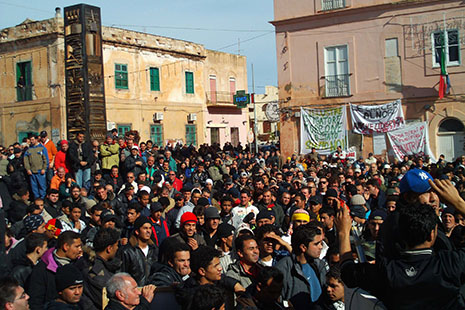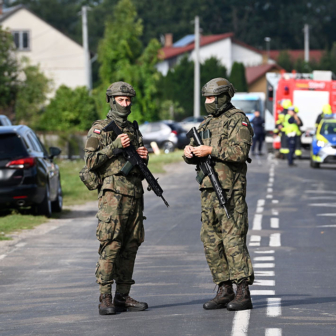LAMPEDUSA is the rocky, arid home to some 6000 permanent residents. Although it belongs to Italy, it has more in common with Tunisian beach resorts than with, say, Elba or Capri – not surprisingly, for it is 113 kilometres from the African coast but 205 kilometres from Sicily.
The Lampedusani, as the islanders call themselves, are dependent on tourism and fishing. Because it is impossible to cultivate the bone-dry soil, most food has to be imported. During the thirsty summer months, when thousands of predominantly Italian tourists spend their holidays there, the Italian military is often forced to airfreight water to the island.
The crystal clear sea, spectacular marine life and small restaurants serving a mixture of Italian and Tunisian cuisine conjure idyllic pictures of dolce far niente. But the other face of Lampedusa is the very antithesis of these images. Lining the harbour are shipwrecks and small, barely seaworthy boats waiting to be removed and destroyed by the Coast Guard. Numerous graves at the local cemetery are marked only with a single letter or number, hinting at untold stories about years spent on the move, dangerous passages in small, overloaded boats and the manifold reasons individuals have for leaving everything behind.
Last year, more than 36,000 “boat people” landed in Italy – more than half of the total number of migrants and refugees who reached Europe by boat. A very large proportion of the boat people accommodated by Italy made their first landfall on Lampedusa. Many don’t get this far, though. Last year alone, Fortress Europe, an Italian non-government organisation, counted 642 documented deaths of boat people on their way to Italy. According to fishermen working in the Strait of Sicily, the actual number of shipwrecks is much higher.
Far away from the centre of Lampedusa’s township, where most of the houses, hotels and shops are located, is a large fenced-off area. That’s where those who managed to survive the perilous journey from the African coast end up. After they have been rescued or intercepted by the Coast Guard they are taken to this grey, inhospitable “reception centre” to be identified. Until recently they were kept there for less than forty-eight hours because they were destined for one of Italy’s sixteen immigration detention centres in Sicily and on the mainland.
There are two types of centres. The CPTs (Centri di Permanenza Temporanea) house people who are about to be deported. They include failed asylum seekers, immigrants who were found to be working without a valid visa, and – according to lawyers – people who didn’t get the chance to apply for asylum because they hail from countries that are considered safe by the authorities. The CIDs (Centri di Identificazione) were set up to host refugees during their asylum procedure. While their requests are being examined the asylum seekers are interned; in the case of an adverse decision they are directly transferred to a CPT for deportation. Because they have only very limited access to lawyers or the UN High Commissioner for Refugees, because the conditions are unhygienic and often overcrowded and because of reports that the police use gratuitous force, both types of detention centres have long been criticised by NGOs, journalists, academics and human rights activists.
Late last year the Italian Minister of the Interior, Roberto Maroni, announced that people landing in Lampedusa without a valid visa would no longer be transferred automatically to a detention camp. But the solutions he has in mind are no better. Since 24 January, decisions about refugee claims have been made on the island itself. With no refugee lawyers on the island, the chance of claimants getting access to legal advice is extremely limited. Because boat people have continued to arrive in Lampedusa, the reception centre is bursting at the seams. Built for 381 people, it now hosts some 2000. As there aren’t enough buildings or beds to accommodate these numbers, many people have had to sleep outdoors under plastic sheets.
To stem the rising number of refugees, Italy’s right-wing coalition government is shifting as much responsibility as possible onto “third countries” with whom Italy enters into agreements to accommodate so-called clandestini (illegal immigrants). Instead of detaining refugees, Maroni wants to legalise mass deportations from Lampedusa to one of Italy’s partner countries in northern or eastern Africa, without allowing the boat people to go through a refugee determination process. But according to the UNHCR, 75 per cent of the boat people arriving in Italy last year applied for asylum, and around 50 per cent of those were granted refugee status or humanitarian protection. Most of the applicants come from conflict regions such as Somalia, Eritrea or Afghanistan.
By trying to “extra-territorialise” as much responsibility as possible, Italy is leading the European Union’s push for a new refugee regime. In 2004 the EU established FRONTEX, the European Agency for the Management of Operational Cooperation at the External Borders, to pave the way for a new approach to illegal migration and flight. The agency’s main task is to coordinate the efforts of member states to police their external borders. It also works with a number of “third countries.” The agency sends experts and expensive equipment, including thermographic cameras, patrol boats and helicopters, to countries like Libya, Morocco, Senegal or Mauritania, which are typical departure points for boat refugees. In situations of “urgent and exceptional pressure,” when large numbers of people try to enter a member state illegally, FRONTEX can draw on the speedboats of its Rapid Border Intervention Teams to hunt boats already on their way to European territory. The main goal is to keep as many people as possible from entering European waters, where they would have the right to apply for asylum.
Through Operation Nautilus, a FRONTEX-brokered deal involving Libya, Malta and Lampedusa, 18,419 migrants were apprehended in 2008. Because the cooperation of Libyan officials was not considered satisfactory, though, Nautilus was declared to have failed. But since then, Italy’s controversial prime minister, Silvio Berlusconi has worked hard to improve the relationship with the Libyan dictator, Colonel Gaddafi. In August 2008 Berlusconi negotiated the so-called accordo di amicizia e cooperazione (treaty of frendship and cooperation) between Rome and Tripolis. According to that bilateral agreement, Italy apologises for the crimes it had committed during the colonisation of Libya with the promise of US$34 billion to be paid over the next twenty-four years. In turn, Gaddafi will provide Europe with gas and oil and guarantee full cooperation in the joint operations against illegal immigration. Berlusconi’s euphoric reaction to this treaty, which has just been ratified by the Italian parliament, may have inspired Roberto Maroni to daydream about the end of the “refugee problem.” Instead of refugees, according to Berlusconi, “only high quality oil and gas will come from Libya!”
What happens to the boat people once they are caught on the high seas or on their way through the Libyan desert? The Italian journalist Gabriele Del Grande has written one of the few detailed reports about the plight of refugees in Libya. He describes people being jammed into containers and deported to large camps (funded by European Union money) in the middle of nowhere, and tells of inhuman living conditions, shortages of food and water, and rapes and mistreatment.
“The first time I heard about migrants deported inside the containers was in the spring of 2006, during an interview with an Eritrean refugee in Italy,” Del Grande writes. “At that time I didn’t want to believe him. The images of hundreds of men, women and children locked inside an iron box in order to be concentrated in a detention camp, without having committed a crime, and then deported, reminded me of the ghosts of the Second World War. They were too harsh to be true. But the image of the containers appeared in all the stories of refugees I met who had passed through Libya. Finally I was able to see those containers with my own eyes.” Libya is not a signatory to the 1951 Refugee Convention, which means that refugees cannot ask for asylum there.
On New Year’s Eve, Maroni made it clear that he would make true his earlier announcement about the end of Lampedusa as an arrival point for boat people. He ordered the deportation of forty-four refugees to Egypt as a prelude to deporting thousands of others who are still in the heavily overcrowded transit centre of Lampedusa.
“At the moment the Italian government excessively tries to stage a kind of panic about refugees. They do this by playing with populist and wrong cards,” says Judith Gleitze, an expert on Italian immigration politics and spokesperson for the German organisation Borderline Europe, which observes and documents incidents at Europe’s borders. “Even if it is true that in 2008 boat arrivals in Italy have increased by 75 per cent, we shouldn’t forget that most illegal immigrants still enter the country with a tourist visa and remain as so-called overstayers.”
The UNHCR’s representative in Italy has expressed his deep concern about Maroni’s plans to deport clandestini as quickly as possible. As for the forty-four people deported to Egypt in December, nobody examined their personal backgrounds or gave them the chance to claim asylum.
Judith Gleitze doesn’t have any illusions about the potential for the “Lampedusian Solution” to lead Italy into violating the 1951 Refugee Convention: “If Maroni allows further deportations directly from Lampedusa, it involves the risk that the number of potential asylum seekers deported without ever having access to the asylum procedure increases substantially.”
Last week, the refugees interned in the overcrowded reception centre on Lampedusa demonstrated that they, too, have a voice. They broke down the fence and organised a demonstration in front of the island’s city hall, demanding an end to their miserable situation. Many Lampedusani welcomed the demonstrators. For years they have been fighting against the government’s plans to build a second camp on the island. They are afraid to be identified as the “island of the unfortunate,” as the Italian media already often calls Lampedusa. They are afraid that such a label will scare off the tourists.
According to Berlusconi, the demonstration proved that those labelling the reception centre on Lampedusa a detention camp were completely wrong. He said that the refugees could freely leave the centre “to have a couple of beers” any time. The day he made this observation, newspapers all over Europe showed pictures of the camp, surrounded by a steel fence, monitored by cameras and guarded like a high security prison by the police. The government responded swiftly to those reports: because journalists reporting about the situation supposedly could “affect public safety” they were denied access to the camp or its perimeter the following day.
Criticism from the UNHCR, human rights experts and journalists doesn’t seem to matter to Berlusconi and his ministers. Instead they doggedly pursue policies designed to limit the number of refugees Italy has to accommodate. Last week the Italian Senate ratified the treaty between Italy and Libya. The following day, Roberto Maroni was in Tripoli to sign an agreement to implement the treaty. Italy is about to hand six patrol boats over to the Libyan government. Maroni expects that the number of boat people making the trip from Africa to Italy will decrease rapidly, and that there’ll be no more crossings by summer: “From now on, the only people to land in Lampedusa will be tourists!” •




